In 2020, the lawmaker representing Kwande/Ushongo Federal Constituency, Robert Aondona Tyough, promised an improved rural electrification project to the people of Tse-Ikpa Haanya, a community in Adikpo, Kwande Local Government Area (LGA) of Benue State. However, today, that promise remains unfulfilled as the transformers stand useless, abandoned, and stripped of cables by vandals. In this report, Mustapha Usman investigates how the project has been left to rot despite multimillionaire funding.
The sun blazes over Tse-Ikpa Haanya, a quiet community in Adikpo, Kwande LGA, Benue State. It is 2:15 p.m., and the air is thick with heat. Beneath a small makeshift shelter, Yorhongo Emmanuel, a 55-year-old resident, wipes sweat from his forehead with the back of his palm. His shirt is soaked through, and he is barely comfortable.
This year’s heat season has been particularly hot for many Benue residents, including Emmanuel, who has had to endure the heat and darkness that come with not having electricity.

Emmanuel and other residents of Tse-Ikpa celebrated when government officials and contractors arrived, promising to provide electricity to the community.Emmanuel, a resident of Tse-Ikpa, believed their nights of tossing in the heat, their days of failed businesses, and the high cost of running generators were finally over. However, his hope has now been dashed, as the project remains incomplete five years “They came to erect the poles you’re seeing and wired them, but after the completion, the contractors and supervisors came to inspect it without powering it. Later, some unknown hoodlums came and vandalized the cables.
“Despite being close to Adikpo town, we have not had the privilege of benefitting from electricity. We are suffering from this abandoned project, which had earlier given us hope of having electricity years ago,” he said.
His plight is not unique, as many other residents of the community who spoke with SMI shared the same sentiment.
For Kimbi Aba, a father of two, the frustration is unbearable. It has always been difficult, but the past few months of heat waves have turned his home into an oven.

Kimbi Aba, while speaking with SMI about his plight, explained that his children now struggle to sleep every night due to the heat.
“Since our community, Mbakwegh, was not electrified before, we residents and villagers were initially hopeful because of the project. But after it failed to take off, we are now back to our original condition.
“The villagers here depend on other sources of light, especially at night, such as torches, solar energy, generators, and phones,” he said.
Early last year, the World Bank approved a $500 million facility to support the country in improving its electricity distribution network. But despite the multiple power sector investments, access has remained a huge challenge.
Bloomberg, in a report, stated that an average home in Nigeria only enjoys power from the national grid for just nine hours. It could be worse in some rural villages, as found in Kwande LGA.
The only possible hope is either to rely on natural ventilation, especially at night or take to rechargeable gadgets.
Background: Abandoned Electrification Project in Kwande LGA
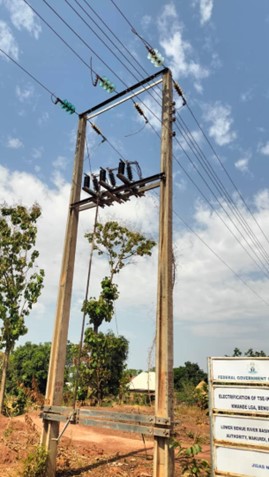
The federal government approved a ₦50 million rural electrification project to upgrade their power supply from an aging 11kVA transformer to a more efficient 33kVA transformer. However, years after its approval, the project remains incomplete, leaving residents in perpetual darkness.
The SMI gathered that the project was part of a broader N400 million federal government investment in Kwande and Ushongo LGAs, approved in 2020 to Kwande/Ushongo federal constituency.
The former lawmaker representing Kwande/Ushongo Federal Constituency, Robert Aondona Tyough, had described the project as a game-changer, one that would improve economic opportunities and transform the lives of residents.
However, despite the government disbursing funds and contractors reportedly completing the project, the transformers stand unused, abandoned, and stripped of cables by vandals.
Data from Budgit, an accountability and transparency platform that tracks federal government projects, revealed that between 2021 and 2022, the government paid ₦50 million for the project.
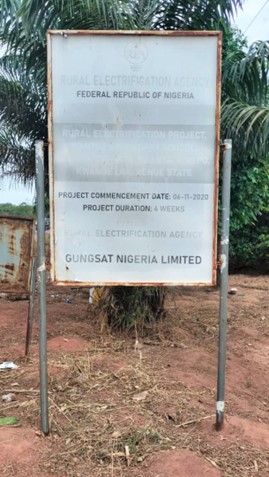
The project was initially awarded to Gungsat Nig. Ltd. at a contract rate of ₦28 million through the Rural Electrification Agency (REA). However, SMI gathered that Gungsat Nig. Ltd. allegedly abandoned the work midway, forcing the government to re-award it to Jidas Nigeria Limited.

The project was re-awarded to Jidas Nigeria Limited for completion, with payments totaling ₦20 million. Yet, despite claims that the project was completed, an on-site investigation showed that it has not been energized and used. Some of the electric poles, piles of cables, fuses, insulators, and other equipment have been left to rot.
Project Completed but JED Failed to Energize It – Contractor

Meanwhile, Jidas Nigeria Limited, which was awarded the project, was responsible for installing the already mounted transformers and extending the transmission line.
When SMI attempted to contact the contractor for clarification, his phone number was unavailable. However, Engineer Michael Ikpa, who directly worked with the contractor and oversaw the installation, confirmed that all work had been completed and that the Nigerian Electricity Management Services Agency (NEMSA) was invited to inspect and certify the project.
According to Ikpa, NEMSA, which operates under the Electricity Act 2023, certified the project as meeting technical standards and safety regulations. The certification was then submitted to JED along with a request to activate the transformers.
NEMSA, established by the NEMSA Act 2015 (now the Electricity Act 2023), has the mandate to enforce technical standards and regulations, conduct technical inspections, testing, and certification of all categories of electrical installations, electricity meters, and instruments. This ensures the efficient production and delivery of safe, reliable, and sustainable electricity power supply while guaranteeing the safety of lives and property within the Nigerian Electricity Supply Industry (NESI) and other allied industries, workplaces, and premises.
“That particular project was awarded to one contractor through REA, which extended a line to some point and installed two transformers. Later, the project was transferred to Jidas through Lower River Benue Basin to install the two transformers that were already on the ground.
“I went and extended the transmission line from the first transformer to the second one. We completed all the installations and invited the Nigerian Electricity Management Services Agency to inspect and certify our work. We sent the approval letter to JED, but they kept giving one excuse after another.
“We erected high-tension poles and cables and completed all the required work. We used a certificate from NEMSA to invite JED, but they kept delaying. Then, about three months later, the transformer was vandalized,” he said.
Despite having all necessary approvals and meeting regulatory requirements, Ikpa noted that JED failed to energize the transformer for several months.
Absence of Electricity Promotes Crime
SMI gathered that the delay ultimately led to vandalism, with criminals stripping cables from the installation, further worsening the community’s electricity crisis.
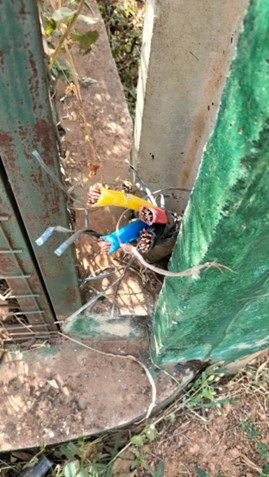
An on-site assessment by this reporter revealed that the lack of illumination in the LGA made it easy for thieves to steal high-extension cables, crossbars, insulators, and other electrical components.
According to residents and Chris, who works near the electrification project, over 10 spans of cables were stolen in Haaya and Adikpo.
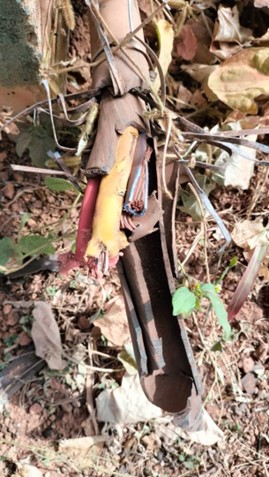
The affected transformers have also been overgrown with grass, rusting away, while erected poles are no longer usable due to insect infestation.
Residents Decry Darkness, Outages Affect Businesses
As the project remains unused, residents of Mbakwegh Council Ward, from Adikpo to Tse-Kpa Comprehensive Secondary School, continue to lament the detrimental effects of the lack of electricity. Businesses have been disrupted, living conditions have worsened, and many struggle to cope with the heat.
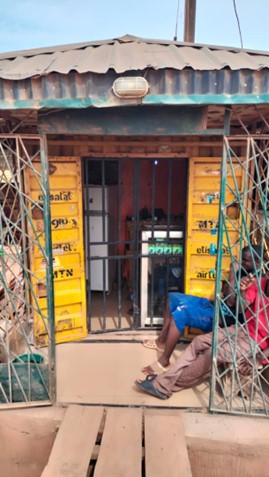
For years, the community has lived without electricity, adjusting to the darkness, relying on expensive generators, and dreaming of a day they would be connected to the national grid.
Terseer Taseer, a local businessman in Tse-Kpa, recalls the excitement that once filled the town in 2020 when the electrification project began.
According to him, workers arrived, installed poles, and stretched power lines across the community—but that was it.
With no power supply, Ama has always relied on a generator to keep his drinks cold. This, he said, impacts his profits.
“The cost of fuel is killing my business,” he said, frustration evident on his face. “Every day, I have to decide whether to run the generator or let my drinks get warm and lose customers.”
“The poles are there, the wires are in place, but no one has come to connect the light,” he explained. “We thought this would help businesses like mine, but nothing has changed.”
The generator, meant to be a temporary solution, has become a financial burden. Due to high fuel prices, his profit margins have shrunk. Without electricity, his business struggles to stay competitive, especially when he cannot afford to fuel the generator.
Students who used to stop by for cold drinks now go elsewhere.
“The cost of fuel and running a business on a generator is difficult. My shop is directly opposite Tse-Kpa Comprehensive Secondary School, and the students always need cold water and soft drinks, but it's hard to rely on a generator because the cost of fuel takes away my profit,” he lamented.
Since assuming office in May 2023, President Tinubu has embarked on a series of economic reforms aimed at stabilizing the nation’s economy. These measures, including the removal of fuel subsidies, have burdened many Nigerians and businesses, making it increasingly difficult to power generators in the absence of electricity.
Charge for Cash

For those who cannot afford the constant expense, they rely only on the dim glow of battery-powered torches to light their way.
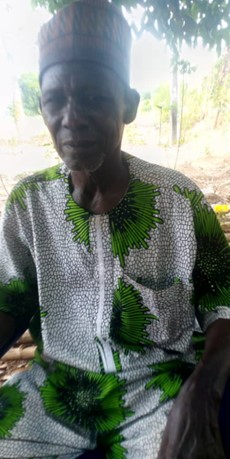
Akpaeregh Tume, a resident of Mbakwegh Community, Kwande LGA, bemoaned the situation, adding, “Since the project was completed, we have not seen light in the community, not even for a day, to use for both commercial and non-commercial activities.
“We have always resorted to using alternative sources of light, such as small torches, phones, and solar energy, especially at night. And we pay around ₦100 to ₦200 to charge them.”
Also expressing his concerns, Kimbi Aba stressed that “most people have to go to Adikpo market or town to charge their phones, which is very pathetic considering that if there was light in Mbakwegh community, we wouldn’t have to.”
No Record of Request to Energize Transformer in Tse-Ikpa Adikpo – JED

Meanwhile, the Jos Electricity Distribution (JED) Plc has stated that there is no record of any request to energize the 300kVA distribution transformer installed for the Tse-Ikpa Adikpo Community in Kwande Local Government Area of Benue State
The letter, signed by Engr. Hamisu Wakili Lizawa, the Acting Chief Technical Officer of JED Plc, granted provisional approval for the connection, subject to strict compliance with the technical and safety standards outlined by the electricity distribution company.
JED Plc emphasized that all materials and equipment used must meet industry specifications, which the contractor claimed had been met.
However, JED’s Head of Corporate Communications, Saratu Dauda, clarified that the company only approved the execution of the project with specific technical and safety requirements but doubted that it ever received a request to connect the transformer to the grid, as no record of such a request exists.
According to Dauda, the December 12, 2022, letter signed by Engr. Hamisu Wakili Lizawa was only a provisional approval for the construction and installation of the transformer. The approval outlined technical specifications for the contractor but did not include permission to energize the transformer.
She noted that the institution has since reviewed its records across multiple offices, including its Makurdi and Gboko branches, and found no documentation indicating that a request for energization was ever submitted.
“What we approved and acknowledged was JED’s authorization for the project to be carried out with certain specifications. Those documents outlined the technical specifications and the requirements the contractors needed to fulfill.
“If we don’t have the letter, we can’t establish that we were instructed to energize the transformer or that our refusal led to the vandalism.
“We have been trying to track the document you’re referring to, but it’s not in our records. I am currently at Jos Headquarters, and I have been interfacing with our staff at the Makurdi and Gboko branches. Based on the documents you shared with us, it was only an approval for the commissioning of the project,” she said.
However, when SMI followed up with the contractor whose license name was used to send the letter, he confirmed that the letter was indeed sent to JED and promised to share the letter with us, but he had yet to do so at the time of filing this report.
This investigation is produced by Safer-Media Initiative with the support of the Wole Soyinka Centre for Investigative Journalism (WSCIJ) under The Collaborative Media Engagement for Development, inclusivity and Accountability Project (C-Media Project) funded by the MacArthur Foundation.
